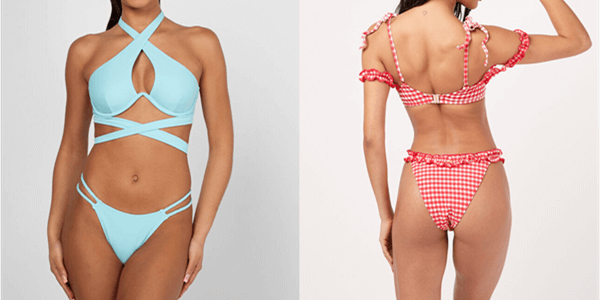
Swimwear vs. Lingerie: Comparing Fabrics for Comfort and Function
Swimwear and lingerie are two types of clothing that require different types of fabrics to be functional and comfortable. The following is a comparison of the most commonly used fabrics for swimwear and lingerie:
| Fabric | Swimwear | Lingerie |
|---|---|---|
| Nylon | ✔️ | ✔️ |
| Polyester | ✔️ | ✔️ |
| Spandex | ✔️ | ✔️ |
| Cotton | ❌ | ✔️ |
| Silk | ❌ | ✔️ |
| Linen | ❌ | ✔️ |
| Rayon | ❌ | ✔️ |
| Modal | ❌ | ✔️ |
| Bamboo | ❌ | ✔️ |
Synthetic Fabrics
Nylon, polyester, and spandex are the three most commonly used synthetic fabrics for swimwear and lingerie. They are known for their high elasticity, durability, and resistance to damage caused by sun, saltwater, and chlorine exposure. Additionally, they provide good support, compression, and shape retention, making them ideal for both types of clothing.
Natural Fibers
Cotton, silk, linen, and wool are natural fibers commonly used in lingerie but not swimwear. Cotton is breathable, soft, and comfortable, but it absorbs water and takes a long time to dry, which makes it unsuitable for swimwear. Silk is a luxurious and lightweight material that is comfortable to wear but not as durable or quick-drying as synthetic materials, making it unsuitable for swimwear. Linen is a light and breathable fabric that is comfortable to wear but does not provide enough stretch or support for swimwear. Wool is warm and comfortable but not quick-drying and absorbs water, making it unsuitable for swimwear.
Other Materials
In addition to the fabrics listed above, other materials that are sometimes used for swimwear and lingerie include rayon, modal, and bamboo. These materials are made from natural fibers but are often blended with synthetic materials to enhance their durability, elasticity, and quick-drying properties.
Unique Treatments and Processing Methods
Regarding swimwear, several unique treatments and processing methods are used on fabrics to make them suitable for use in the water. For example, swimwear fabrics are often treated with chemicals such as chlorine-resistant finishes, UV protectants, and water repellents to improve their durability, protect against fading, and repel water. Swimwear fabrics are often made using specialized weaving techniques that provide extra stretch and support, such as circular or warp knit.
Conclusion
Choosing a suitable fabric for swimwear and lingerie is crucial for comfort and performance. By understanding the properties of different fabrics and their processing methods, you can select the appropriate material for the proper purpose and ensure that your clothing is comfortable, durable, and functional. Synthetic materials like nylon, polyester, and spandex are ideal for swimwear, while natural fibers like cotton, silk, and linen are preferred for lingerie.
